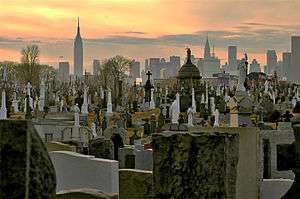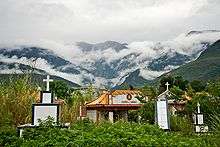Cemetery

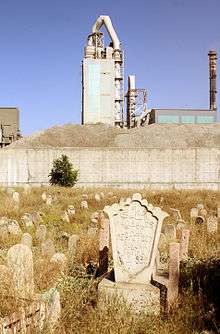

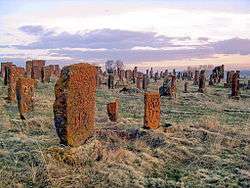
A cemetery or graveyard is a place where the remains of dead people are buried or otherwise interred. The word cemetery (from Greek κοιμητήριον, "sleeping place")[1][2] implies that the land is specifically designated as a burial ground. The term graveyard is often used interchangeably with cemetery, but primarily referred to a burial ground within a churchyard.[3][4]
The intact or cremated remains of people may be interred in a grave, commonly referred to as burial, or in a tomb, an "above-ground grave" (resembling a sarcophagus), a mausoleum, columbarium, niche, or other edifice. In Western cultures, funeral ceremonies are often observed in cemeteries. These ceremonies or rites of passage differ according to cultural practices and religious beliefs. Modern cemeteries often include crematoria, and some grounds previously used for both, continue as crematoria as a principal use long after the interment areas have been filled.
Definition
The Oxford English Dictionary defines a cemetery as a "burial-ground generally; now esp. a large public park or ground laid out expressly for the internment of the dead, and not being the ‘yard’ of any church. (Cemetery c)" and specifies that the term "...originally applied to the Roman underground cemeteries or catacombs "[5] Cemeteries are normally distinct from churchyards, which are typically consecrated according to one denomination and are attached directly to a single place of worship.
History
Prehistory
Prehistoric cemeteries are sometimes referred to by the term "grave field". They are one of the chief sources of information on ancient and prehistoric cultures, and numerous archaeological cultures are defined by their burial customs, such as the Urnfield culture of the European Bronze Age.
Early Christianity
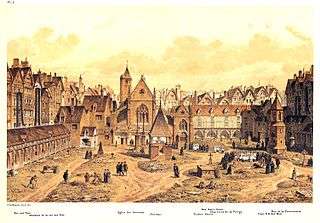
From about the 7th century, European burial was under the control of the Church and could only take place on consecrated church ground. Practices varied, but in continental Europe, bodies were usually buried in a mass grave until they had decomposed. The bones were then exhumed and stored in ossuaries, either along the arcaded bounding walls of the cemetery, or within the church under floor slabs and behind walls.
In most cultures those who were vastly rich, had important professions, were part of the nobility or were of any other high social status were usually buried in individual crypts inside or beneath the relevant place of worship with an indication of their name, date of death and other biographical data. In Europe this was often accompanied with a depiction of their coat of arms.
Most others were buried in graveyards again divided by social status. Mourners who could afford the work of a stonemason had a headstone engraved with a name, dates of birth and death and sometimes other biographical data, and set up over the place of burial. Usually, the more writing and symbols carved on the headstone, the more expensive it was. As with most other human property such as houses and means of transport, richer families used to compete for the artistic value of their family headstone in comparison to others around it, sometimes adding a statue (such as a weeping angel) on the top of the grave.
Those who could not pay for a headstone at all usually had some religious symbol made from wood on the place of burial such as a Christian cross; however, this would quickly deteriorate under the rain or snow. Some families hired a blacksmith and had large crosses made from various metals put on the place of burial.
Modernity
Starting in the early 19th century, the burial of the dead in graveyards began to be discontinued, due to rapid population growth in the early stages of the Industrial Revolution, continued outbreaks of infectious disease near graveyards and the increasingly limited space in graveyards for new interment. In many European states, burial in graveyards was eventually outlawed altogether through government legislation.
Instead of graveyards, completely new places of burial were established away from heavily populated areas and outside of old towns and city centers. Many new cemeteries became municipally owned or were run by their own corporations, and thus independent from churches and their churchyards.
In some cases, skeletons were exhumed from graveyards and moved into ossuaries or catacombs. A large action of this type occurred in 18th century Paris when human remains were transferred from graveyards all over the city to the Catacombs of Paris. The bones of an estimated 6 million people are to be found there.[6]
An early example of a landscape-style cemetery is Père Lachaise in Paris. This embodied the idea of state- rather than church-controlled burial, a concept that spread through the continent of Europe with the Napoleonic invasions. This could include the opening of cemeteries by private or joint stock companies. The shift to municipal cemeteries or those established by private companies was usually accompanied by the establishing of landscaped burial grounds outside the city (e.g. extramural).

In Britain the movement was driven by dissenters and public health concerns. The Rosary Cemetery in Norwich was opened in 1819 as a burial ground for all religious backgrounds. Similar private non-denominational cemeteries were established near industrialising towns with growing populations, such as Manchester (1821) and Liverpool (1825). Each cemetery required a separate Act of Parliament for authorisation, although the capital was raised through the formation of joint-stock companies.
In the first 50 years of the 19th century the population of London more than doubled from 1 million to 2.3 million. The small parish churchyards were rapidly becoming dangerously overcrowded, and decaying matter infiltrating the water supply was causing epidemics. The issue became particularly acute after the cholera epidemic of 1831, which killed 52,000 people in Britain alone, putting unprecedented pressure on the country's burial capacity. Concerns were also raised about the potential public health hazard arising from the inhalation of gases generated from human putrefaction under the then prevailing miasma theory of disease.
Legislative action was slow in coming, but in 1832 Parliament finally acknowledged the need for the establishment of large municipal cemeteries and encouraged their construction outside London. The same bill also closed all inner London churchyards to new deposits. The Magnificent Seven, seven large cemeteries around London, were established in the following decade, starting with Kensal Green in 1832.[7]
Urban planner and author John Claudius Loudon was one of the first professional cemetery designers, and his book On the Laying Out, Planting and Managing of Cemeteries (1843) was very influential on designers and architects of the period. Loudon himself, designed three cemeteries - Bath Abbey Cemetery, Histon Road Cemetery, Cambridge, and Southampton Old Cemetery.[8]
The Metropolitan Burial Act of 1852 legislated for the establishment of the first national system of government funded municipal cemeteries across the country, opening the way for a massive expansion of burial facilities throughout the late 19th century.[9]
Types

There are a number of different styles of cemetery in use. Many cemeteries have areas based on different styles, reflecting the diversity of cultural practices around death and how it changes over time.
Urban
The urban cemetery is a burial ground located in the interior of a village, town, or city. Early urban cemeteries were churchyards, which filled quickly and exhibited a haphazard placement of burial markers as sextons tried to squeeze new burials into the remaining space. As new burying grounds were established in urban areas to compensate, burial plots were often laid out in a grid to replace the chaotic appearance of the churchyard.[11] Urban cemeteries developed over time into a more landscaped form as part of civic development of beliefs and institutions that sought to portray the city as civilized and harmonious.[12]
Urban cemeteries were more sanitary (a place to safely dispose of decomposing corpses) than they were aesthetically pleasing. Corpses were usually buried wrapped in cloth, since coffins, burial vaults, and above-ground crypts inhibited the process of decomposition.[13] Nonetheless, urban cemeteries which were heavily used were often very unhealthy. Receiving vaults and crypts often needed to be aired before entering, as decomposing corpses used up so much oxygen that even candles could not remain lit.[14] The sheer stench from decomposing corpses, even when buried deeply, was over overpowering in areas adjacent to the urban cemetery.[15][16] Decomposition of the human body releases significant pathogenic bacteria, fungi, protozoa, and viruses which can cause disease and illness, and many urban cemeteries were located without consideration for local groundwater. Modern burials in urban cemeteries also release toxic chemicals associated with embalming, such as arsenic, formaldehyde, and mercury. Coffins and burial equipment can also release significant amounts of toxic chemicals such as arsenic (used to preserve coffin wood) and formaldehyde (used in varnishes and as a sealant) and toxic metals such as copper, lead, and zinc (from coffin handles and flanges).[17]
Urban cemeteries relied heavily on the fact that the soft parts of the body would decompose in about 25 years (although, in moist soil, decomposition can take up to 70 years).[18] If room for new burials was needed, older bones could be dug up and interred elsewhere (such as in an ossuary) to make space for new interments.[13] It was not uncommon in some places, such as England, for fresher corpses to be chopped up to aid decomposition, and for bones to be burned to create fertilizer.[19] The re-use of graves allowed for a steady stream of income, which enabled the cemetery to remain well-maintained and in good repair.[20] Not all urban cemeteries engaged in re-use of graves, and cultural taboos often prevented it. Many urban cemeteries have fallen into disrepair and become overgrown, as they lacked endowments to fund perpetual care. Many urban cemeteries today are thus home to wildlife, birds, and plants which cannot be found anywhere else in the urban area, and many urban cemeteries in the late 20th century touted their role as an environmental refuge.[21][22]
Many urban cemeteries are characterized by multiple burials in the same grave. Multiple burials is a consequence of the limited size of the urban cemetery, which cannot easily expand due to adjacent building development. It was not uncommon for an urban cemetery to begin adding soil to the top of the cemetery, to create new burial space. In some cases, cemeteries rose 10 to 15 feet (3.0 to 4.6 m) above the level of the surrounding streets, and heavy retaining walls were built to keep the cemetery (and corpses) from falling into the street.[23][24]
Monumental
A monumental cemetery is the traditional style of cemetery where headstones or other monuments made of marble, granite or similar materials rise vertically above the ground (typically around 50 cm but some can be over 2 metres high). Often the entire grave is covered by a slab, commonly concrete, but it can be more expensive materials such as marble or granite, and/or has its boundaries delimited by a fence which may be made of concrete, cast iron or timber. Where a number of family members are buried together (either vertically or horizontally), the slab or boundaries may encompass a number of graves. Monumental cemeteries are often regarded as unsightly due to the random collection of monuments and headstones they contain. Also, as maintenance of the headstones is the responsibility of family members (in the absence of a proscribed Perpetual Care and Maintenance Fund), over time many headstones are forgotten about and decay and become damaged. For cemetery authorities, monumental cemeteries are difficult to maintain. While cemeteries often have grassed areas between graves, the layout of graves makes it difficult to use modern equipment such as ride-on lawn mowers in the cemetery. Often the maintenance of grass must be done by more labour-intensive (and therefore expensive) methods. In order to reduce the labour cost, devices such as string trimmers are increasingly used in cemetery maintenance, but such devices can damage the monuments and headstones. Cemetery authorities dislike the criticism they receive for the deteriorating condition of the headstones, arguing that they have no responsibility for the upkeep of headstones, and typically disregard their own maintenance practices as being one of the causes of that deterioration.
Rural or garden
The rural cemetery or garden cemetery[25] is a style of burial ground that uses landscaping in a park-like setting. It was conceived in 1711 by the British architect Sir Christopher Wren, who advocated the creation of landscaped burial grounds which featured well-planned walkways which gave extensive access to graves and planned plantings of trees, bushes, and flowers.[26] Wren's idea was not immediately accepted. But by the early 1800s, existing churchyards were growing overcrowded and unhealthy, with graves stacked upon each other or emptied and reused for new burials.[27] As a reaction to this, the first "garden" cemetery—Père Lachaise Cemetery in Paris—opened in 1804.[28] Because these cemeteries were usually on the outskirts of town (where land was plentiful and cheap), they were called "rural cemeteries", a term still used to describe them today.[27] The concept quickly spread across Europe.[29]
Garden/rural cemeteries were not necessarily outside city limits. When land within a city could be found, the cemetery was enclosed with a wall to give it a garden-like quality. These cemeteries were often not sectarian, nor co-located with a house of worship. Inspired by the English landscape garden movement,[30] they often looked like attractive parks. The first garden/rural cemetery in the United States was Mount Auburn Cemetery near Boston, Massachusetts, founded by the Massachusetts Horticultural Society in 1831.[31]
The cost of building a garden/rural cemetery often meant that only the wealthy could afford burial there.[32] Subsequently, garden/rural cemeteries often feature above-ground monuments and memorials, mausoleums, and columbaria. The excessive filling of rural/garden cemeteries with elaborate above-ground memorials, many of dubious artistic quality or taste, created a backlash which led to the development of the lawn cemetery.[33]
Lawn
Traditional lawn
A lawn cemetery (as the name suggests) is covered in grass. Each grave is marked with a commemorative plaque (around 30 cm x 20 cm is typical) placed horizontally at the head of the grave at ground-level. While families are normally still involved in the design and information contained on the plaque, cemetery authorities generally constrain the size and materials of the plaque and often strongly encourage (or in some cases mandate) the use of a standard design.
Typically, lawn cemeteries comprise a number of graves in this lawn setting with trees and gardens on the perimeter. Adolph Strauch introduced this style in 1855 in Cincinnati.[34] While aesthetic appeal to family members has been the primary driver for the development of lawn cemeteries, cemetery authorities initially welcomed this new style of cemetery enthusiastically, expecting easier maintenance. Selecting (or grading) the land intended for a lawn cemetery so that it is completely flat allows the use of large efficient mowers (such as ride-on mowers or lawn tractors) - the plaques (being horizontally set in the ground) lie below the level of the blades and are not damaged by the blades. Unfortunately, in practice, while families are often initially attracted to the uncluttered appearance of a lawn cemetery, the common practice of placing flowers (sometimes in vases) and increasingly other items (e.g. small toys on children's graves) re-introduces some clutter to the cemetery and makes it difficult to use the larger mowers. While cemetery authorities increasingly impose restrictions on the nature and type of objects that can be placed on lawn graves and actively remove prohibited items, grieving families are often unwilling to comply with these restrictions and become very upset if the items are removed. Another problem with lawn cemeteries involves grass over-growth over time: the grass can grow over and cover the plaque, to the distress of families who can no longer easily locate the grave. Grasses that propagate by an above-ground stolon (runner) can cover a plaque very quickly. Grasses that propagate by a below-ground rhizome tend not to cover the plaque as easily.
Lawn beam
The lawn beam cemetery, a recent development, seeks to solve the problems of the lawn cemetery while retaining many of its benefits. Low (10–15 cm) raised concrete slabs (beams) are placed across the cemetery. Commemorative plaques (usually standardised in terms of size and materials similar to lawn cemeteries) stand on these beams adjacent to each grave. As in a lawn cemetery, grass grows over the graves themselves. The areas between the beams are wide enough to permit easy mowing with a larger mower. As the mower blades are set lower than the top of the beam and the mowers do not go over the beam, the blades cannot damage the plaques. Up on the beam, the plaques cannot be easily overgrown by grass, and spaces between the plaques permit families to place flowers and other objects out of reach of the mowing.
Natural
A natural cemetery or eco-cemetery or green cemetery is a new style of cemetery and is an area set aside for natural burials (with or without coffins). Natural burials are motivated by a desire to be environmentally conscious with the body rapidly decomposing and becoming part of the natural environment without incurring the environmental cost of traditional burials. Although in principle natural burial can be performed in any style of cemetery, typically the environmental motivations of those requesting natural burial tend to favor the use of a natural bushland or woodland setting for the natural burial. Because of the number of trees usually present in a natural cemetery, burials occur in whatever location and orientation best fits the natural environment as opposed to the more traditional rows or other orderly arrangements in traditional cemeteries. As a consequence, natural burial may actually be less efficient land-use than a traditional cemetery. However, because of the rapid decomposition of a natural burial, in principle the re-use of the grave site can occur earlier than in other conventional burials, which would improve the efficiency of land use. However, it remains to be seen if family members will accept the early re-use of natural burial sites, given the general community dislike of re-use of any kind of grave. Another consequence of the lack of orderly burials is the need for highly accurate surveying of the grave site for effective cemetery management, to prevent the accidental re-use of a grave site.
In keeping with the intention of "returning to nature" and the early re-use potential, natural cemeteries do not normally have conventional grave markings such as headstones. Instead, the planting of a tree or bush or placement of a rock is regarded as the more appropriate way to commemorate the dead. However, as with other types of cemetery, the intentions of the cemetery authorities may be in conflict with the grieving practices of family and friends, for whom being able to visit the precise location of a grave and read the headstone is often important. In some natural cemeteries, names can be inscribed on naturally-shaped rocks (not carved headstones) but, unless the rock is particularly large and heavy, it can easily be knocked or kicked to another nearby location.
Columbarium wall
Columbarium walls are a common feature of many cemeteries, reflecting the increasing use of cremation rather than burial. While cremated remains can be kept at home by families in urns or scattered in some significant or attractive place, neither of these approaches allows for a long-lasting commemorative plaque to honour the dead nor provide a place for the wider circle of friends and family to come to mourn or visit. Therefore, many cemeteries now provide walls (typically of brick or rendered brick construction) with a rectangular array of niches, with each niche being big enough to accommodate a person's cremated remains. Columbarium walls are a very space-efficient use of land in a cemetery compared with burials and a niche in a columbarium wall is a much cheaper alternative to a burial plot. A small plaque (about 15 cm x 10 cm) can be affixed across the front of each niche and is generally included as part of the price of a niche. As the writing on the plaques has to be fairly small to fit on the small size of the plaque, the design of columbarium walls is constrained by the ability of visitors to read the plaques. Thus, the niches are typically placed between 1 metre to 2 metres above the ground so the plaques can be easily read by an adult. Some columbarium walls have niches going close to ground level, but these niches are usually unpopular with families as it is difficult to read the plaque without bending down very low (something older people in particular find difficult or uncomfortable to do).
As with graves, the niches may be assigned by the cemetery authorities or families may choose from the unoccupied niches available. It is usually possible to purchase (or pay a deposit) to reserve the use of adjacent niches for other family members. The use of adjacent niches (vertically or horizontally) usually permits a larger plaque spanning all the niches involved, which provides more space for the writing. As with graves, there may be separate columbarium walls for different religions or for war veterans. As with lawn cemeteries, the original expectation was that people would prefer the uncluttered simplicity of a wall of plaques, but the practice of leaving flowers is very entrenched. Mourners leave flowers (and other objects) on top of columbarium walls or at the base, as close as they can to the plaque of their family member. In some cases, it is possible to squeeze a piece of wire or string under the plaque allowing a flower or small posy to be placed on the plaque itself or clips are glued onto the plaque for that purpose. Newer designs of columbarium walls take this desire to leave flowers into account by incorporating a metal clip or loop beside each plaque, typically designed to hold a single flower stem or a small posy. As the flowers decay, they simply fall to the ground and do not create a significant maintenance problem.
Family
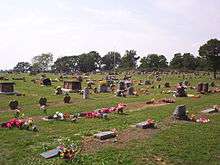

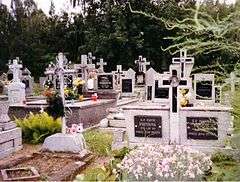
While uncommon today, family (or private) cemeteries were a matter of practicality during the settlement of America. If a municipal or religious cemetery had not been established, settlers would seek out a small plot of land, often in wooded areas bordering their fields, to begin a family plot. Sometimes, several families would arrange to bury their dead together. While some of these sites later grew into true cemeteries, many were forgotten after a family moved away or died out.
Today, it is not unheard of to discover groupings of tombstones, ranging from a few to a dozen or more, on undeveloped land. As late 20th century suburban sprawl pressured the pace of development in formerly rural areas, it became increasingly common for larger exurban properties to be encumbered by "religious easements," which are legal requirements for the property owner to permit periodic maintenance of small burial plots located on the property but technically not owned with it. Often, cemeteries are relocated to accommodate building. However, if the cemetery is not relocated, descendants of people buried there may visit the cemetery.[35]
More recent is the practice of families with large estates choosing to create private cemeteries in the form of burial sites, monuments, crypts, or mausoleums on their property; the mausoleum at Fallingwater is an example of this practice. Burial of a body at a site may protect the location from redevelopment, with such estates often being placed in the care of a trust or foundation. Presently, state regulations have made it increasingly difficult, if not impossible, to start private cemeteries; many require a plan to care for the site in perpetuity. Private cemeteries are nearly always forbidden on incorporated residential zones. Many people will bury a beloved pet on the family property.
Arabian tribal
Most of the Saudis in Al Baha are Muslims, and this is reflected in their cemetery and funeral customs. "The southern tribal hinterland of Baha — home to especially the Al-Ghamdi and Al-Zahrani tribes — has been renowned for centuries for their tribal cemeteries that are now slowly vanishing", according to the Asharq Al-Awsat newspaper: "One old villager explained how tribal cemeteries came about. 'People used to die in large numbers and very rapidly one after the other because of diseases. So the villagers would dig graves close by burying members of the same family in one area. That was how the family and tribal burial grounds came about... If the family ran out of space, they would open old graves where family members had been buried before and add more people to them. This process is known as khashf.'" During famines and outbreaks of epidemics huge numbers of people would die and many tribes faced difficulties in digging new graves because of the difficult weather. In the past, some Arab winters lasted for more than six months and would be accompanied with lots of rain and fog, which made movement difficult. But due to tribal rivalries many families would guard their cemeteries and put restrictions on who got buried in them. Across Baha, burial grounds have been constructed in different ways. Some cemeteries consist of underground vaults or concrete burial chambers with the capacity of holding a large number of bodies at a time. Such vaults include windows for people to peer through and are usually decorated ornately with text, drawings, and patterns. At least one resident believes that the graves unique in the region because many are not oriented toward Mecca, and therefore must pre-date Islam.[36]
Miscellaneous
The Cross Bones is a burial ground for prostitutes in London, and the Neptune Memorial Reef is an underwater columbarium near Key Biscayne.
Customs and practices
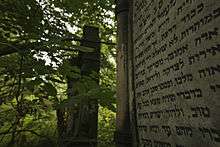

Flowers
In Western countries, and many others, visitors to graves commonly leave cut flowers, especially during major holidays and on birthdays or relevant anniversaries. Cemeteries usually dispose of these flowers after a few weeks in order to keep the space maintained. Some companies offer perpetual flower services, to ensure a grave is always decorated with fresh flowers.[37] Flowers may often be planted on the grave as well, usually immediately in front of the gravestone. For this purpose roses are highly common.
Stones
Visitors to loved ones interred in Jewish cemeteries often leave a small stone on the top of the headstone. There are prayers said at the gravesite, and the stone is left on the visitor's departure. It is done as a show of respect; as a general rule, flowers are not placed at Jewish graves. Flowers are fleeting; the symbology inherent in the use of a stone is to show that the love, honor, memories, and soul of the loved one are eternal. This practice is seen in the closing scene of the film Schindler's List, although in that case it is not on a Jewish grave.
Crosses
War graves will commonly have small timber crosses left with a red poppy attached to its centre. These will often have messages written on the cross. More formal visits will often leave a poppy wreath. Jewish war graves are sometimes marked by a timber Star of David.
Candles
Placing burning grave candles on the cemetery to commemorate dead is a very common tradition in Poland. It is mostly practised on All Souls' Day. The traditional grave candles are called znicz in Polish.[38]
Contemporary management
Traditionally cemetery management only involves the allocation of land for burial, the digging and filling of graves, and the maintenance of the grounds and landscaping. The construction and maintenance of headstones and other grave monuments are usually the responsibilities of surviving families and friends. However, increasingly, many people regard the resultant collection of individual headstones, concrete slabs and fences (some of which may be decayed or damaged) to be aesthetically unappealing, leading to new cemetery developments either standardising the shape or design of headstones or plaques, sometimes by providing a standard shaped marker as part of the service provided by the cemetery.
Grave digging
Cemetery authorities normally employ a full-time staff of caretakers to dig graves. The term "gravedigger" is still used in casual speech, though many cemeteries have adopted the term "caretaker", since their duties often involve maintenance of the cemetery grounds and facilities. The employment of skilled personnel for the preparation of graves is done not only to ensure the grave is dug in the correct location and at the correct depth, but also to relieve families from having to dig the grave for a recently dead relative, and as a matter of public safety, in order to prevent inexperienced visitors from injuring themselves, to ensure unused graves are properly covered, and to avoid legal liability that would result from an injury related to an improperly dug or uncovered grave. Preparation of the grave is usually done before the mourners arrive for the burial. The cemetery caretakers fill the grave after the burial, generally after the mourners have departed. Mechanical equipment, such as backhoes, are used to reduce labour cost of digging and filling, but some hand shovelling may still be required.
In the United Kingdom the minimum depth from the surface to the highest lid is 36 inches. There must be 6 inches between each coffin, which on average is 15 inches high. If the soil is free draining and porous, only 24 inches of soil on top is required. Coffins may be interred at lesser depths or even above ground as long as they are encased in a concrete chamber.[39] Before 1977, double graves were dug to 8 feet and singles to 6 feet. As a single grave is now dug to 54 inches, old cemeteries contain many areas where new single graves can be dug on "old ground". This is considered a valid method of resource management and provides income to keep older cemeteries viable, thus forestalling the need for permanent closure, which would result in a reduction of their work force.
Burial registers
Usually there is a legal requirement to maintain records regarding the burials (or interment of ashes) within a cemetery. These burial registers usually contain (at a minimum) the name of the person buried, the date of burial and the location of the burial plots within the cemetery, although some contain far more detail. The Arlington National Cemetery, one of the United States' largest military cemeteries, has a registry, The ANC Explorer, which contains details such as photographs of the front and back of the tombstones.[40] Burial registers are an important resource for genealogy.
Land use
In order to physically manage the space within the cemetery (to avoid burials in existing graves) and to record locations in the burial register, most cemeteries have some systematic layout of graves in rows, generally grouped into larger sections as required. Often the cemetery displays this information in the form of a map, which is used both by the cemetery administration in managing their land use and also by friends and family members seeking to locate a particular grave within the cemetery.
Pressures

Cemetery authorities face a number of tensions in regard to the management of cemeteries.
One issue relates to cost. Traditionally a single payment is made at the time of burial, but the cemetery authority incurs expenses in cemetery maintenance over many decades. Many cemetery authorities find that their accumulated funds are not sufficient for the costs of long-term maintenance. This shortfall in funds for maintenance results in three main options: charge much higher prices for new burials, obtain some other kind of public subsidy, or neglect maintenance. For cemeteries without space for new burials, the options are even more limited. Public attitudes towards subsidies are highly variable. People with family buried in local cemeteries are usually quite concerned about neglect of cemetery maintenance and will usually argue in favour of public subsidy of local cemetery maintenance, whereas other people without connection to the area often argue that public spending comes from their taxes and therefore should be spent on the living in the district rather than being wasted on the dead.
Another issue relates to limited amount of land. In many larger towns and cities, the older cemeteries which were initially considered to be large often run out of space for new burials and there is no vacant adjacent land available to extend the cemetery or even land in the same general area to create new cemeteries. New cemeteries are generally established on the periphery of towns and cities, where large tracts of land are still available. However, people often wish to be buried in the same cemetery as other relatives, creating pressure to find more space in existing cemeteries and are not interested in being buried in new cemeteries with which there is no sense of connection to their family.
A third issue is the maintenance of monuments and headstones, which are generally the responsibility of families, but often become neglected over time. Decay and damage through vandalism or cemetery maintenance practices can render monuments and headstones either unsafe or at least unsightly. On the other hand, some families do not forget the grave but constantly visit, leaving behind flowers, plants, and other decorative items that create their own maintenance problem.
Re-use of graves
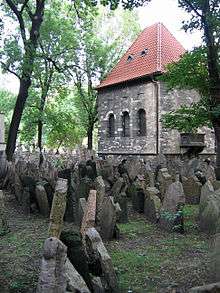

All of these issues tend to put pressure on the re-use of grave sites within cemeteries. The re-use of graves already used for burial can cause considerable upset to family members. Although the authorities might declare that the grave is sufficiently old that there will be no human remains still present, nonetheless many people regard the re-use of graves (particularly their family's graves) as a desecration. Also re-use of a used grave involves the removal of any monuments and headstones, which may cause further distress to families (although families will typically be allowed to take away the monuments and headstones if they wish).
On the other hand, cemetery authorities are well aware that many old graves are forgotten and not visited and that their re-use will not cause distress to anyone. However, there may be some older graves in a cemetery for whom there are local and vocal descendants who will mount a public campaign against re-use. One pragmatic strategy is to publicly announce plans to re-use older graves and invite families to respond if they are willing or not. Re-use then only occurs where there are no objections allowing the "forgotten" graves to be re-used. Sometimes the cemetery authorities request a further payment to avoid re-use of a grave, but often this backfires politically.
A practical problem with regard to contacting families is that the original person who organised a burial may themselves also be dead and buried and locating living family members many decades later is virtually impossible (or at least prohibitively expensive). Therefore, communication about re-use in local cemeteries tends to occur only through in local publications, which often do not reach family members living further afield who may only become aware of the re-use of the grave after the event (and after the removal and destruction of monuments and headstones).
Some cemeteries did foresee the need for re-use and included in their original terms and conditions a limited tenure on a grave site and most new cemeteries follow this practice, having seen the problems faced by older cemeteries. However, even when the cemetery has the legal right to re-use a grave, strong public opinion often forces the authorities to back down on that re-use. Also, even when cemeteries have a limited tenure provision in place, often funding shortages force them to contemplate re-use earlier than the original arrangements provided for.
Another type of grave site that must be considered for re-use are those that have never been used (but have been purchased at some time for future use). In principle it would seem easier to re-use such grave sites as there can be no claims of desecration, but often this is made more complicated by the legal rights to be buried obtained by the pre-purchase, as any limited tenure clause only takes effect after there has been a burial. Again, cemetery authorities suspect that in many cases the holders of these burial rights are probably dead and that nobody will exercise that burial right, but again some families are aware of the burial rights they possess and do intend to exercise them as and when family members die. Again the difficulty of being unable to locate the holders of these burial rights complicates the re-use of those graves.
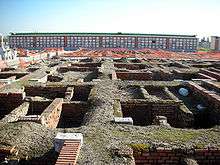
As historic cemeteries begin to reach their capacity for full burials, alternative memorialization, such as collective memorials for cremated individuals, is becoming more common. Different cultures have different attitudes to destruction of cemeteries and use of the land for construction. In some countries it is considered normal to destroy the graves, while in others the graves are traditionally respected for a century or more. In many cases, after a suitable period of time has elapsed, the headstones are removed and the now former cemetery is converted to a recreational park or construction site. A more recent trend, particularly in South American cities, involves constructing high-rise buildings to house graves.[42]
Cemeteries in the United States may be relocated if the land is required for other reasons. For instance, many cemeteries in the southeastern United States were relocated by the Tennessee Valley Authority from areas about to be flooded by dam construction.[43] Cemeteries may also be moved so that the land can be reused for transportation structures,[44][45] public buildings,[46] or even private development.[47] Cemetery relocation is not necessarily possible in other parts of the world; in Alberta, Canada, for instance, the Cemetery Act expressly forbids the relocation of cemeteries or the mass exhumation of marked graves for any reason whatsoever.[48] This has caused significant problems in the provision of transportation services to the southern half of the City of Calgary, as the main southbound road connecting the south end of the city with downtown threads through a series of cemeteries founded in the 1930s. The light rail transit line running to the south end eventually had to be built directly under the road.
Maintenance and mourning
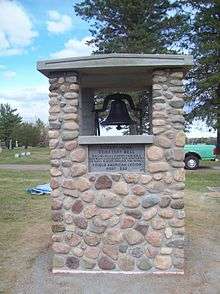
Cemetery authorities also face tension between the competing demands of efficient maintenance with the needs of mourners.
Labour costs in particular have risen substantially and so finding low-cost maintenance methods (meaning low-labour maintenance methods) is increasingly important. However, as discussed above, the use of large mowers and string trimmers might be efficient but often cannot be used in cemeteries because they physically are too large to fit between graves or because they can damage the monuments and headstones. In this regard, older cemeteries designed at a time of relatively low-cost labour and limited automation tend to present the greatest difficulties for maintenance.
On the other hand, newer cemeteries might be designed to be more efficiently maintained with lower labour through the increased use of equipment, e.g. lawn cemeteries where the maintenance can be performed with a ride-on mower or lawn tractor. However, efficient maintenance of newer graves is often frustrated by the actions of mourners who often place flowers and other objects on graves. These objects often require manual intervention; in some cases objects will be picked up and returned after maintenance, in other cases (e.g. dead flowers) they will be disposed of.
Again, although cemetery authorities try to prohibit the quantity and nature of objects placed on graves (a common restriction is to allow only fresh flowers, not in a vase or pot), but mourning families might ignore any such regulations and become very upset if other objects are removed. In particular, in an era in which the death of children is now relatively uncommon, some parents create quite large shrines at their child's grave, decorating them with toys, wind chimes, statues of angels and cherubs, etc. as a manifestation of their grief, adding items to the pile of objects on the grave progressively over time. Cemetery authorities have to try to deal with such situations sensitively, as strong emotions are involved. However, as well as their own maintenance problems with such "shrines", families with graves in the surrounding area often complain to cemetery authorities about the "mess", as they believe it detracts from the dignity of their family's graves. Therefore, the cemetery authorities must find a solution that satisfies both parties.
Superstitions
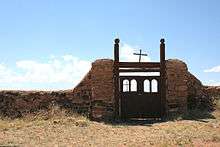
In many countries, cemeteries are places believed to hold both superstition and legend characteristics, being used, usually at night times, as an altar in supposed black magic ceremonies or similarly clandestine happenings, such as devil worshipping, grave-robbing (gold teeth and jewelry are preferred), thrilling sex encounters or drug and alcohol abuse not related to the cemetery aura (see below).
The legend of zombies, as romanticized by Wade Davis in The Serpent and the Rainbow, is not exceptional among cemetery myths, as cemeteries are believed to be places where witches and sorcerers get skulls and bones needed for their sinister rituals.
In the Afro-Brazilian urban mythos (such as Umbanda), there is a character loosely related to cemeteries and its aura: the Zé Pilintra (in fact, Zé Pilintra is more related to bohemianism and night life than with cemeteries, where the reigning entity is Exu Caveira or Exu Cemitério, similar to Voodoo Baron Samedi).
See also
Other types of burial places
- Catacomb
- Churchyard
- Coemeterium
- Columbarium
- Crypt
- Mass grave
- Memorial Park
- Necropolis
- Ossuary
- Tomb
- Tumulus
- Unmarked grave
- War grave
Regional variations of burial places and practices
Specific types of burial places
- Mausoleum
- Megalithic tomb
- Natural burial
- Potter's field
- Reliquary
- Sepulchre
- Shaft and chamber tomb
- Stupa
- Stone ship
- Tomb of the Unknown Soldier
Removal of remains from cemeteries
Businesses and professions for cemeteries
Public holidays and traditions in relation to cemeteries
- All Souls' Day
- Bon Festival
- Day of the Dead
- Decoration Day
- Memorial Day
- National day of mourning
- Qingming Festival
- Saturday of Souls
Further aids to find cemetery locations or names of those buried
Other topics related to places of burial
Notes
- ↑ κοιμητήριον. Liddell, Henry George; Scott, Robert; A Greek–English Lexicon at the Perseus Project
- ↑ Harper, Douglas. "cemetery". Online Etymology Dictionary.
- ↑ "Know Your English: Difference between 'graveyard' and 'cemetery'". The Hindu. October 25, 2011.
- ↑ "What's the Difference Between a Graveyard and a Cemetery". January 19, 2013.
- ↑ "cemetery". Oxford English Dictionary (3rd ed.). Oxford University Press. September 2005. (Subscription or UK public library membership required.)
- ↑ "Paris' Secret Underworld". CBS News. September 27, 2004
- ↑ Meller, Hugh (1981). London Cemeteries: An Illustrated Guide and Gazetteer. Amersham: Avebury. ISBN 0-86127-003-7.
- ↑ Melanie Louise Simo (1988) Loudon and the Landscape, p. 283.
- ↑ "The Historical Development of Cemeteries in England".
- ↑ Lomax, John Nova. "The Seoul of Houston: The Weather Was Not the Strong Point on Long Point." Houston Press. January 30, 2008.
- ↑ Mytum 2004, p. 50.
- ↑ Worpole 2003, pp. 11–12.
- 1 2 Nonini 2014, p. 390.
- ↑ Flanders 2014, p. 220.
- ↑ Carroll 2013, p. 362.
- ↑ Upton 1997, p. 131-132.
- ↑ Taylor & Allen 2006, pp. 342–342.
- ↑ Meuser 2010, p. 137.
- ↑ Flanders 2014, pp. 219–221.
- ↑ Worpole 2003, p. 8.
- ↑ Worpole 2003, p. 173.
- ↑ Forman 2014, pp. 357–358.
- ↑ Cantor 2010, p. 93.
- ↑ Flanders 2014, p. 219.
- ↑ Keels 2003, p. 21.
- ↑ van Rensslaer, M. G. (June 3, 1891). "Garden and Forest". Sir Christopher Wren as Gardener: 254–255.
- 1 2 LeeDecker 2009, pp. 145, 148.
- ↑ Thomas 2003, p. 32.
- ↑ Mickey & 2013 page-17.
- ↑ Vercelloni, & Vercelloni 2010, p. 198.
- ↑ Hodgson 2001, p. 30.
- ↑ Harney 2014, p. 102.
- ↑ Mytum 2004, p. 51.
- ↑ Sears, John F. (1989). Sacred Places: American Tourist Attractions in the Nineteenth Century. University of Massachusetts Press. pp. 117–118. ISBN 9781558491625. Retrieved 2013-07-25.
First introduced in 1855 by Adolph Strauch, superintendent of the Spring Grove Cemetery in Cincinnati, the park or lawn cemetery featured open, uncluttered expanses of lawn rather than the uneven, wooded, picturesque scenery of the rural cemetery. [...] By the final decades of the nineteenth century, the park cemetery would become the dominant form of American burial ground.
- ↑ Alfred Brophy, Grave Matters: The Ancient Rights of the Graveyard
- ↑ "Tradition of Family Cemeteries Disappearing From Tribal Areas." Arab News. Tuesday, 2 October 2012 | Dhulka'edah 16, 1433
- ↑ "City cemetery draws visitors for 150 years"
- ↑ "Zaduszkowe tradycje". TVP Białystok (in Polish). November 2, 2012.
- ↑ Local Authorities Cemeteries Order 1977
- ↑ "Arlington National Cemetery Records Go Online". OnlineSearches News 11.01.2012
- ↑ "Tomb with a view". BBC News. March 6, 2002
- ↑ News: New trend: Cemetery Skyscrapers Archived November 11, 2006, at the Wayback Machine.
- ↑ Cemeteries Relocated by TVA. Accessed July 13, 2009.
- ↑ "O'Hare Growth May Mean Moving a Cemetery". NPR, November 19, 2005. Accessed July 13, 2009.
- ↑ St. Johannes Cemetery Relocation. Accessed July 13, 2009.
- ↑ "Remains in 19th century graves downtown ID'd as soldiers". The Tucson Citizen, April 17, 2009. Accessed July 13, 2009.
- ↑ "Cemetery Relocation Battle Ongoing". Archived May 9, 2008, at the Wayback Machine. Platte County Citizen, July 4, 2007. Accessed July 13, 2009.
- ↑ Cemetery Act of Alberta. Accessed July 13, 2009.
Bibliography
- Cantor, Norman L. (2010). After We Die: The Life and Times of the Human Cadaver. Washington, D.C.: Georgetown University Press. ISBN 9781589017139.
- Carmack, Sharon DeBartolo (2002). Your Guide to Cemetery Research. Betterway Books. ISBN 978-1558705890.
- Carroll, Andrew (2013). Here Is Where: Discovering America's Great Forgotten History. New York: Crown Archetype. ISBN 9780307463999.
- Colvin, Howard (1991). Architecture and the After-Life. New Haven: Yale University Press.
- Curl, James Stevens (2002). Death and Architecture. Gloucestershire: Sutton.
- Etlin, Richard A. (1984). The Architecture of Death: the transformation of the cemetery in eighteenth-century Paris. Cambridge, MA: MIT Press.
- Flanders, Judith (2014). The Victorian City: Everyday Life in Dickens' London. New York: Thomas Dunne Books. ISBN 9781250040213.
- Forman, Richard T.T. (2014). Urban Ecology: Science of Cities. Cambridge, U.K.: Cambridge University Press. ISBN 9781107007000.
- Grossman, Janet Burnett (2001). Greek Funerary Sculpture. Catalogue of the Collection at the Getty Villa. Los Angeles: J. Paul Getty Museum.
- Harney, Marion (2014). Gardens and Landscapes in Historic Building Conservation. Chichester, West Sussex, U.K.: John Wiley & Sons. ISBN 9781118508121.
- Hodgson, Larry (2001). The Garden Lover's Guide to Canada. New York: Princeton Architectural Press. ISBN 1568982798.
- Keels, Thomas H. (2003). Philadelphia Graveyards and Cemeteries. Charleston, S.C.: Arcadia. ISBN 9780738512297.
- LeeDecker, Charles H. (2009). "Preparing for an Afterlife of Earth: The Transformation of Mortuary Behavior in Nineteenth-Century North America". In Majewski, Teresita; Gaimster, David R. M. International Handbook of Historical Archaeology. New York: Springer. ISBN 9780387720685.
- Meuser, Helmut (2010). Contaminated Urban Soils. Dordrecht, Netherlands: Springer. ISBN 9789048193271.
- Mickey, Thomas J. (2013). America's Romance With the English Garden. Athens, Ohio: Ohio University Press. ISBN 9780821420355.
- Mytum, Harold (2004). Mortuary Monuments and Burial Grounds of the Historic Period. New York: Kluwer Academic Publishing. ISBN 0306480751.
- Nonini, Donald Macon (2014). A Companion to Urban Anthropology. Malden, Mass.: Wiley-Blackwell. ISBN 9781118378649.
- Salisbury, Mike. "From My Death May Life Come Forth. A Feasibility Study of the Woodland Cemetery in Canada". Earthartist.com.
- Taylor, Richard; Allen, Alistair (2006). "Waste Disposal and Landfill: Potential Hazards and Information Needs". In Schmoll, Oliver; Howard, Guy; Chilton, John; Chorus, Ingrid. Protecting Groundwater for Health: Managing the Quality of Drinking-Water Sources. Cornwall, U.K.: World Health Organisation. ISBN 9781843390794.
- Thomas, Jeannie B. (2003). Naked Barbies, Warrior Joes, and Other Forms of Visible Gender. Urbana, Ill.: University of Illinois Press. ISBN 9780252028540.
- Upton, Dell (1997). "The Urban Cemetery and the Urban Community: The Origin of the New Orleans Cemetery". In adams, Annmarie; McMurry, Sally Ann. Exploring Everyday Landscapes. Knoxville, Tenn.: University of Tennessee Press. ISBN 9780870499838.
- Vercelloni, Matteo; Vercelloni, Virgilio (2010). Inventing the Garden. Los Angeles: J. Paul Getty Museum. ISBN 9781606060476.
- Worpole, Ken (2003). Last Landscapes: the architecture of the cemetery in the West. London: Reaktion Books. ISBN 186189161X.
External links
| Wikimedia Commons has media related to Cemeteries. |
| Wikivoyage has a travel guide for Cemeteries. |
- Cemeteries at DMOZ
